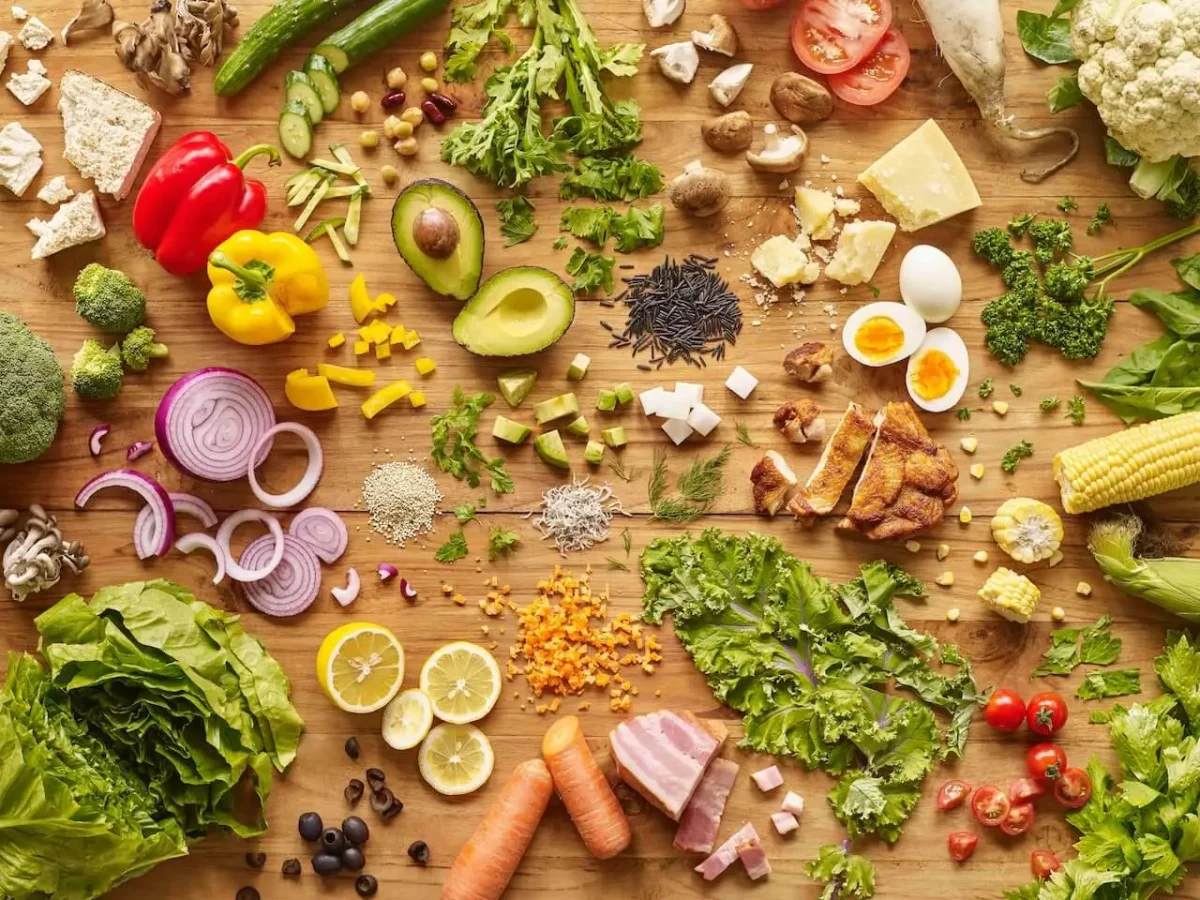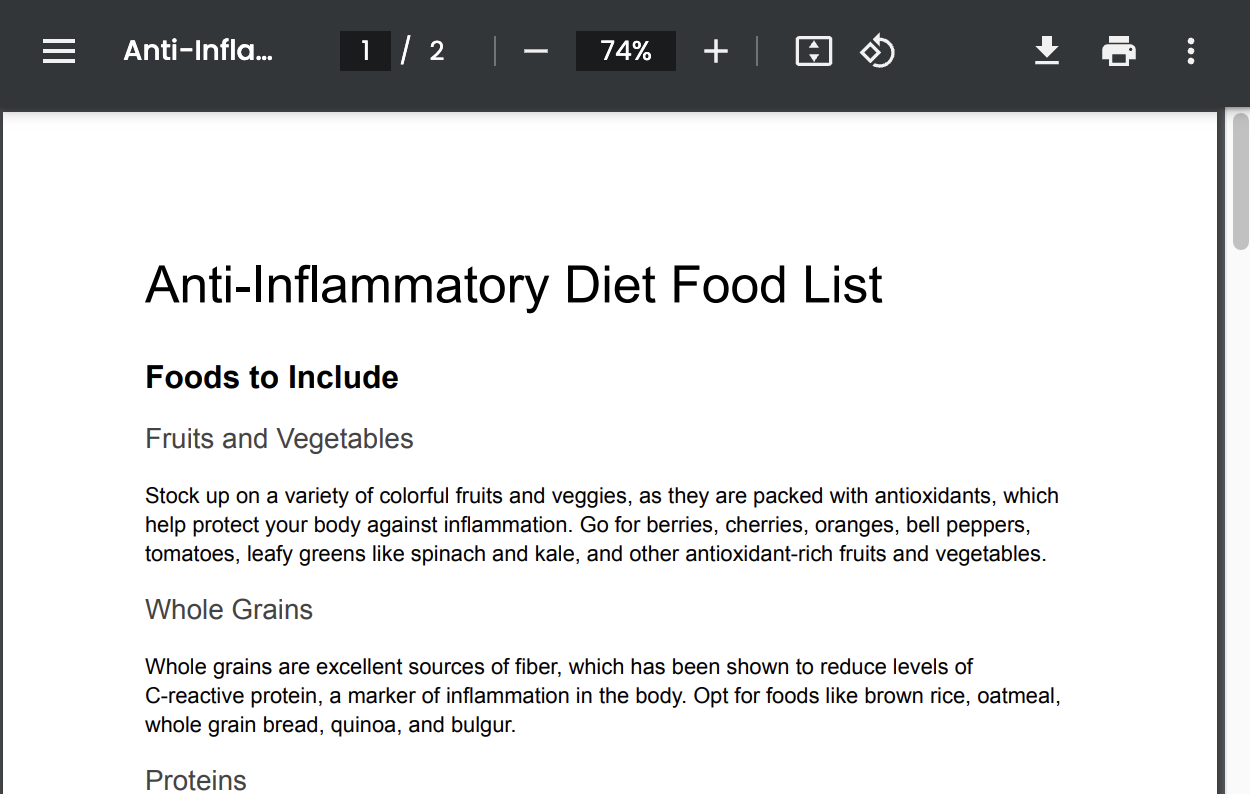Understand the relationship between diet and inflammation, make conscious food choices, and help your body fight against persistent, chronic inflammation. This is the core premise of the «21-Day Anti-inflammatory Diet».
Download the printable 21-Day Anti-Inflammatory Diet PDF for free.
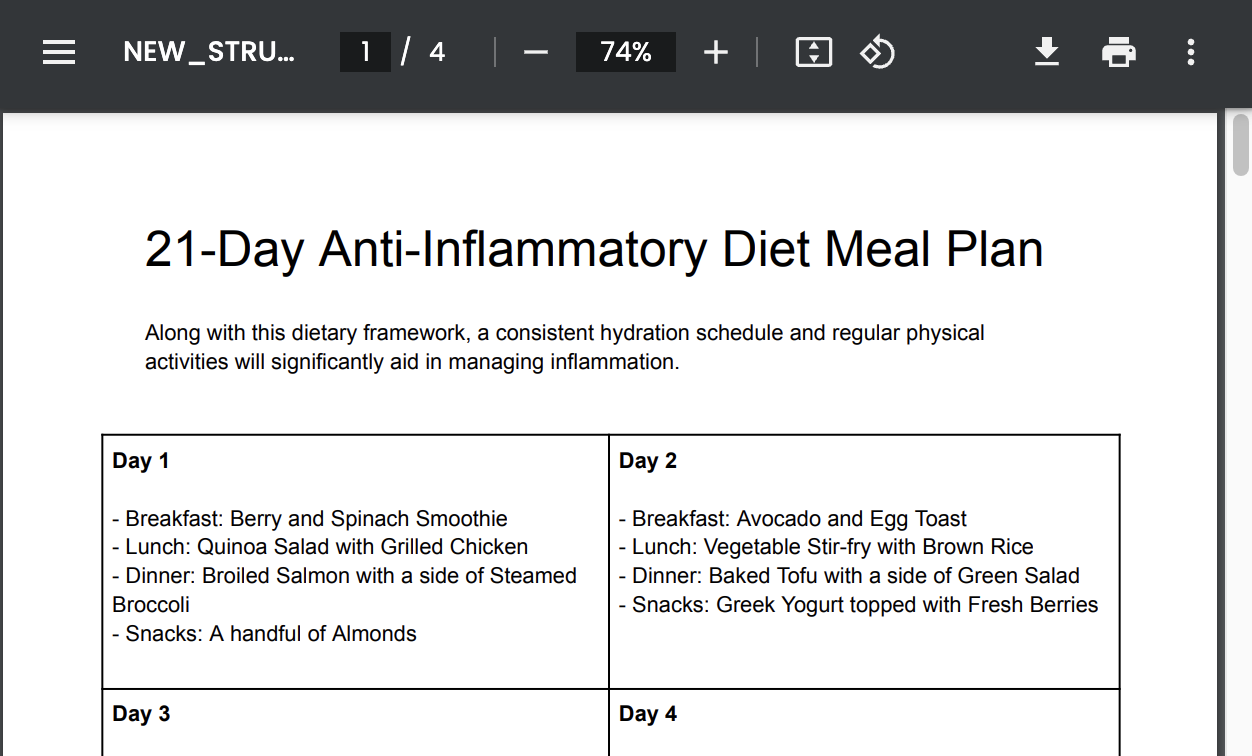
Introduction
Let’s be honest, you need a healthier lifestyle to combat inflammation. This lifestyle change is founded on the understanding that certain foods can promote inflammation, while others can prevent and even reduce it.
But what is inflammation, and why does it matter so much? Inflammation is a crucial part of your body’s immune response. It’s how your body protects itself against diseases, injuries, and infections. However, when inflammation gets out of control and becomes chronic, it can lead to several health issues, including heart disease, diabetes, cancer, and arthritis, among others.
The core of this 21-day plan is not about restricting your diet to the extreme, but rather embracing a variety of wholesome, nutrient-dense foods that can help to balance your immune system and cultivate better health.
Over this course, we aim to provide a mix of delicious, natural, and varied meals designed to reduce the pro-inflammatory foods in your diet while increasing your intake of foods that have natural anti-inflammatory benefits.
Keep in mind, this is not just a «diet» — it’s a lifestyle modification. You won’t just be learning what to eat, but also how and why to eat these foods. By the end of this journey, the goal is not only to see positive changes in your overall health and wellbeing, but also to have equipped you with knowledge and habits that you can sustain over time.


Understanding Inflammation
Inflammation is often portrayed negatively, but it’s crucial to understand that it’s not entirely bad. Inflammation is a key component of your body’s defense mechanism. It is the body’s natural response to protect itself against harm, including infections, injuries, or toxins, in an attempt to heal itself.
When something harmful affects a part of our body, the immune system recognizes the damaged cells, irritants, or pathogens, and initiates the process of inflammation. During this process, your body’s white blood cells and the substances they produce go to work by increasing blood flow to the area of injury or infection. This response might lead to short-term symptoms like redness, heat, swelling, and pain — the signs that your body is combating these foreign invaders.
However, not all inflammation is visible or even painful. There’s another type of inflammation that’s more insidious — chronic inflammation. It occurs when this inflammatory state lingers, failing to return to a normal state. This extended period of inflammation can potentially damage tissues and organs. Research links chronic inflammation to various health issues such as heart disease, diabetes, autoimmune diseases, and even cancer.
The cause of chronic inflammation varies. It might be due to an untreated infection or disease, an autoimmune disorder where the immune system mistakenly attacks healthy tissues, or lifestyle factors that could induce it. Poor diet, lack of exercise, stress, and bad habits like smoking and excessive drinking contribute largely to elevating inflammatory responses in the body.
This is where diet comes into play. What we consume can significantly affect the levels of inflammation within our bodies. Certain foods can exacerbate this inflammatory response, whereas others have the power to mitigate it. By being mindful of our food choices, we elevate the potential control we have over inflammation and, consequently, our health.
Benefits of the Anti-inflammatory Diet
Adopting an anti-inflammatory diet is about much more than just combatting inflammation. The scope of benefits this dietary approach can bring is remarkably wide-ranging. Here are some key benefits that an anti-inflammatory diet has to offer.
Fight Inflammatory Conditions
As expected, an anti-inflammatory diet can help manage inflammatory conditions. Whether it’s autoimmune conditions like rheumatoid arthritis or inflammatory bowel disease, a diet rich in anti-inflammatory foods can help control the body’s inflammatory response and alleviate symptoms.
Improved Heart Health
Foods in the anti-inflammatory diet are high in natural antioxidants and polyphenols, plant compounds that are beneficial for heart health. These foods can also help lower blood pressure and cholesterol levels, reduce the risk of plaque build-up in artery walls, and prevent other factors contributing to heart diseases.
Supports Weight Management
Anti-inflammatory foods are rich in fiber, which keeps you feeling satiated for longer periods. This can help control unnecessary snacking and manage portion sizes, which will support weight loss or maintenance.
Promotes Gut Health
Inflammation is a leading cause of many gut-related issues like bloating, irregular bowel movements, and irritable bowel syndrome. Foods included in this diet are known to support the gut’s microbiome, reducing these symptoms and promoting better digestion and nutrient absorption.
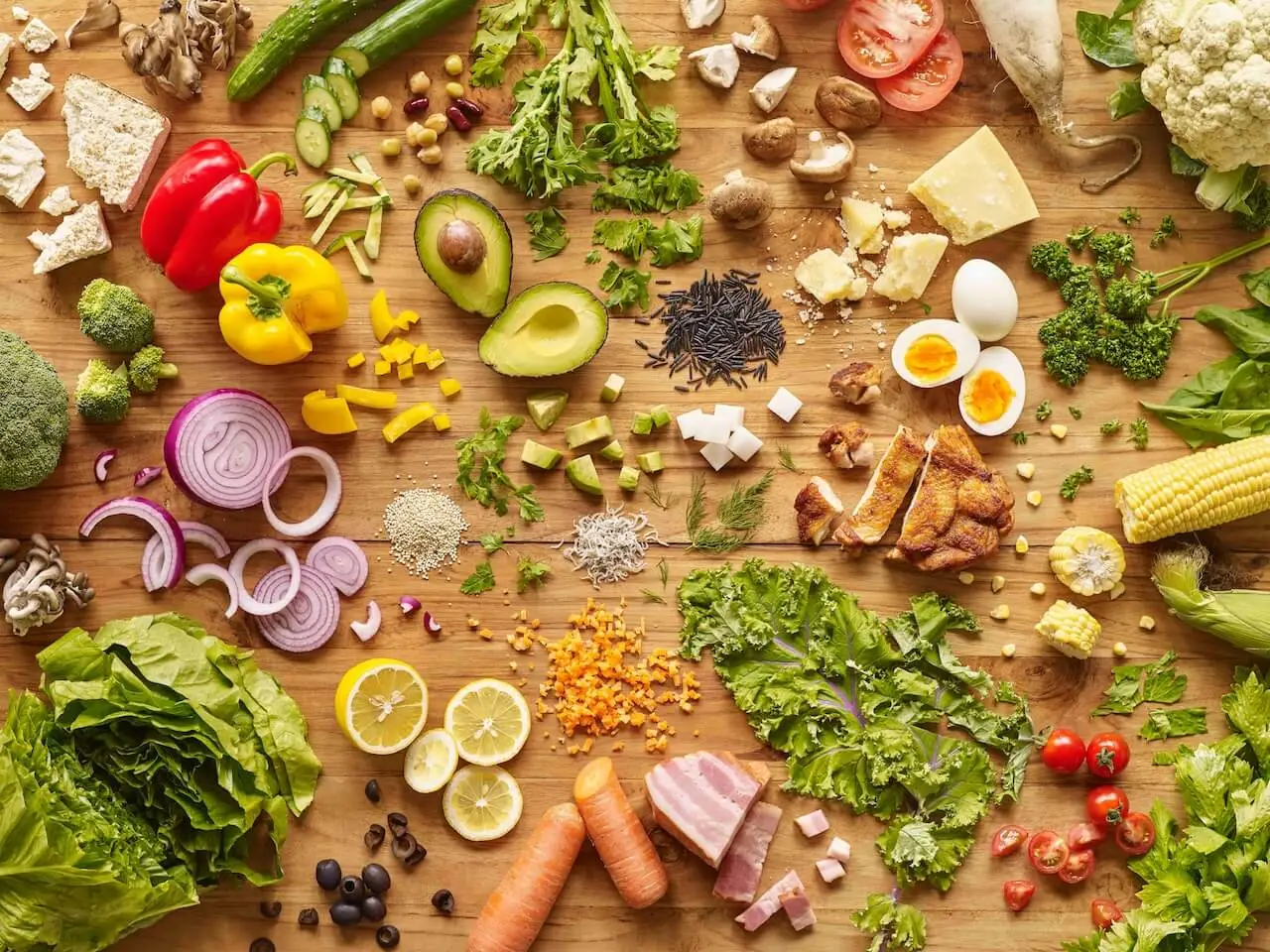

Boosts Immune System
Anti-inflammatory foods are often packed with antioxidants, minerals, and essential vitamins that boost immune health, making you more resistant to infections and diseases.
Mental Health Improvements
Recent studies suggest a strong link between chronic inflammation and mental health disorders like depression, anxiety, and mood swings. Nutrient-dense, anti-inflammatory foods can potentially improve mental health by easing inflammation and boosting brain health.
Enhanced Energy Levels and Better Sleep
This diet promotes balanced blood sugar and supports adrenal function which can result in consistent energy levels throughout the day and better sleep patterns.
Foods to Include
The cornerstone of the anti-inflammatory diet is a wide variety of vibrantly colored fruits and vegetables, whole grains, lean protein, and beneficial fats. All of these foods are packed with antioxidants, fiber, vitamins, and other essential nutrients that help reduce inflammation. Here are some key food groups to focus on in your anti-inflammatory diet.
Fruits and Vegetables
Stock up on a variety of colorful fruits and veggies, as they are packed with antioxidants, which help protect your body against inflammation. Go for berries, cherries, oranges, bell peppers, tomatoes, leafy greens like spinach and kale, and other antioxidant-rich fruits and vegetables.
Whole Grains
Whole grains are excellent sources of fiber, which has been shown to reduce levels of C-reactive protein, a marker of inflammation in the body. Opt for foods like brown rice, oatmeal, whole grain bread, quinoa, and bulgur.
Proteins
It is important to opt for lean proteins such as fish, particularly those high in Omega-3 fatty acids like salmon and mackerel, which have been proven to reduce inflammation. Other sources include lean poultry, tofu, tempeh, beans, lentils, and eggs.
Healthy Fats
Not all fats are bad. Some fats, especially Omega-3 fatty acids, are known for their anti-inflammatory effects. Foods rich in these healthy fats include avocados, nuts and seeds (like almonds and chia seeds), and olive oil.
Herbs and Spices
Many herbs and spices are packed with antioxidant and anti-inflammatory compounds. Turmeric, with its active ingredient curcumin, has potent anti-inflammatory properties. Ginger and cinnamon are also known for relieving inflammation.
Teas and Hydrating Beverages
Hydration is crucial. Apart from drinking ample amounts of water, go for rejuvenating teas like green tea, chamomile tea, or herbal infusions. They’re rich in antioxidants and provide anti-inflammatory benefits.
Implementing these foods into your diet can make a significant difference to your body’s inflammation levels. However, it’s equally important to know which foods are likely to trigger inflammation, so let’s look at those next.
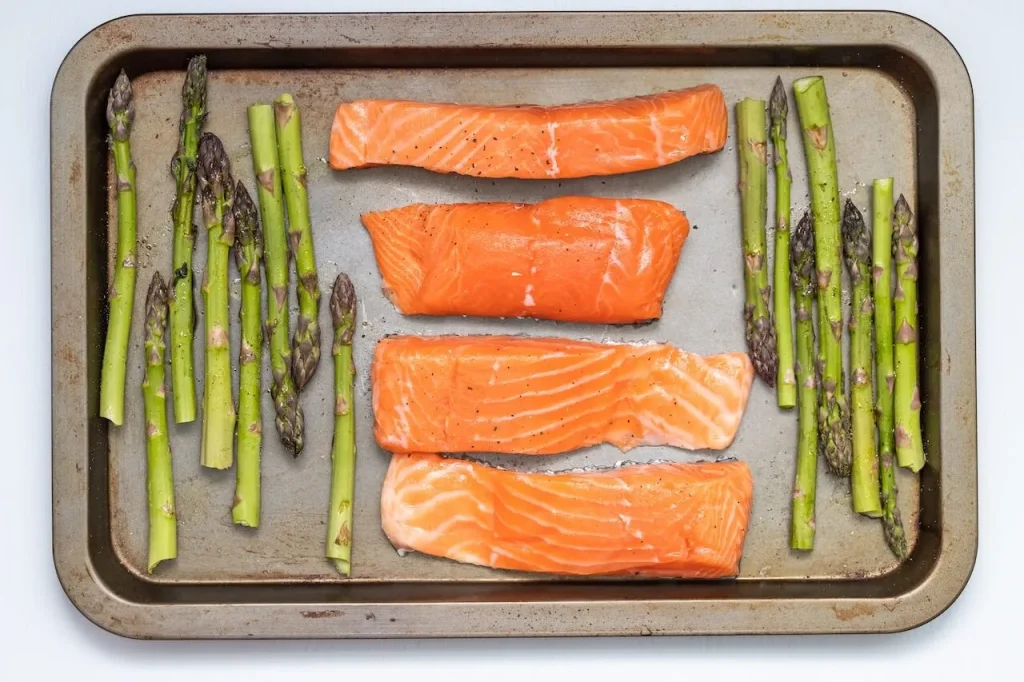

Foods to Avoid
While there are plenty of foods that can help tame the fire of inflammation, others can fan the flames, promoting higher levels of inflammation. Here are some main culprits to consider:
Refined Carbohydrates
White bread, white pasta, and many cereals are refined carbohydrates. These have most of their fiber removed and can cause a rise in blood sugar levels, leading to inflammation.
Sugar and High-Fructose Corn Syrup
Excessive sugar intake can trigger the release of inflammatory messengers called cytokines. Steer clear of sodas, candies, and even certain types of fruit juices due to their high sugar content.
Fried and Processed Foods
Fast foods and others that are fried, greasy, or heavily processed are known to stimulate inflammation. This includes items like French fries, savory snacks, instant noodles, and processed meats.
Red and Processed Meat
Consuming high amounts of red meat (such as beef, pork, and lamb) and processed meat (like hot dogs, sausage, and bacon) can contribute to inflammation.
Trans Fats
Often found in fried foods, pastries, cookies, and donuts, trans fats are notorious inducers of inflammation. They are sometimes listed on food labels as “partially hydrogenated oils,” so be sure to avoid them.
Excessive Alcohol
While moderate amounts of alcohol may reduce inflammation, excessive intake does the exact opposite, promoting inflammation.
Certain Cooking Oils
Some vegetable and seed oils are high in omega-6 fatty acids, which, in excess, can promote inflammation. They include sunflower, corn, safflower, and soybean oils.
Reducing or eliminating these pro-inflammatory foods from your diet can dramatically decrease inflammation and start to tip the scale toward optimal health.
21-Day Anti-Inflammatory Diet Meal Plan
This is a comprehensive meal plan. Feel free to customize this diet plan to suit your palate and health needs, while prioritizing foods that combat inflammation. Along with this dietary framework, a consistent hydration schedule and regular physical activities will significantly aid in managing inflammation.
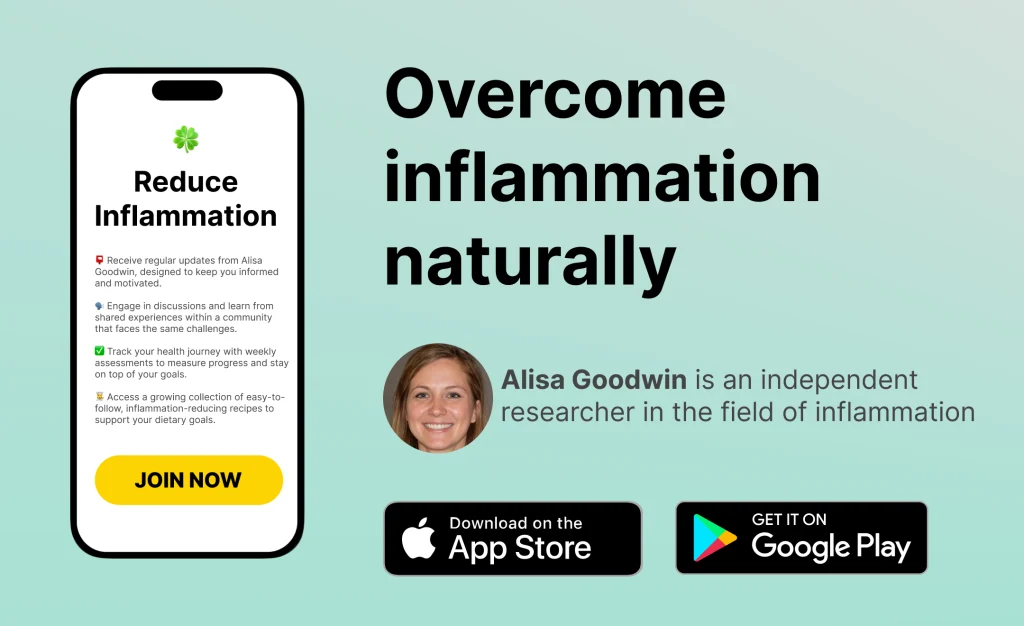




Day 1
– Breakfast: Berry and Spinach Smoothie
– Lunch: Quinoa Salad with Grilled Chicken
– Dinner: Broiled Salmon with a side of Steamed Broccoli
– Snacks: A handful of Almonds
Day 2
– Breakfast: Avocado and Egg Toast
– Lunch: Vegetable Stir-fry with Brown Rice
– Dinner: Baked Tofu with a side of Green Salad
– Snacks: Greek Yogurt topped with Fresh Berries
Day 3
– Breakfast: Overnight Oats with Mixed Berries
– Lunch: Lentil Soup with a Whole Grain Roll
– Dinner: Grilled Mackerel with a side of Roasted Veggies
– Snacks: A Banana
Day 4
– Breakfast: Quinoa Porridge with Nuts and Seeds
– Lunch: Chickpea Salad with an Olive-Oil Dressing
– Dinner: Vegetable Curry with Brown Rice
– Snacks: Orange Slices
Day 5
– Breakfast: Spinach and Tomato Omelet
– Lunch: Grilled Turkey Sandwich with a Whole-grain Bread
– Dinner: Baked Cod with Asparagus
– Snacks: Raw Carrots with Hummus
Day 6
– Breakfast: Chia Seed Pudding with Berries and a sprinkle of Cinnamon
– Lunch: Quinoa Tabouli
– Dinner: Chicken Stir-fry with a side of Mixed Greens Salad
– Snacks: Apple Slices
Day 7
– Breakfast: Scrambled Eggs with Avocado and Salsa
– Lunch: Vegetable Soup with a Whole Grain Roll
– Dinner: Grilled Salmon with a side of Sweet Potato Mash
– Snacks: A handful of Walnuts
Day 8
– Breakfast: Greek Yogurt with Fresh Berries and a Spoonful of Flaxseed
– Lunch: Grilled Vegetables with a Balsamic Glaze
– Dinner: Lemon and Dill Roasted Salmon with a side of Sautéed Spinach
– Snacks: A handful of Walnuts
Day 9
– Breakfast: Whole Grain Cereal with Almond Milk
– Lunch: Chicken Salad with Olives, Tomatoes and Cucumbers
– Dinner: Chickpea Curry with a side of Brown Rice
– Snacks: Sliced Apples
Day 10
– Breakfast: Bananas and Blueberries with Almond Butter
– Lunch: Lentil Soup with Whole Grain Bread
– Dinner: Grilled Trout with a side of Quinoa Salad
– Snacks: Celery Sticks with Hummus
Day 11
– Breakfast: Toasted Whole Grain Bread with Avocado and Poached Eggs
– Lunch: Tuna Salad with a Mix of Green Leaves and Lemon Dressing
– Dinner: Stuffed Eggplant with a side of Couscous
– Snacks: Orange Slices
Day 12
– Breakfast: Green Smoothie (Spinach, Banana, and Chia Seeds)
– Lunch: Beans Salad with a Dijon Mustard Dressing
– Dinner: Grilled Chicken with a side of Steamed Asparagus
– Snacks: A handful of Almonds
Day 13
– Breakfast: Oatmeal with Fresh Berries and a sprinkle of Cinnamon
– Lunch: Quinoa Stuffed Bell Peppers
– Dinner: Seafood Paella
– Snacks: Greek Yogurt with Fresh Berries
Day 14
– Breakfast: Scrambled Tofu with Avocado on a Whole Grain Toast
– Lunch: Chicken and Vegetable Stir-fry
– Dinner: Zucchini Spaghetti with a side of Grilled Salmon
– Snacks: A Banana
Day 15
– Breakfast: Berry and Spinach Smoothie
– Lunch: Grilled Chicken and Quinoa Salad
– Dinner: Baked Trout with Lemon, Garlic and Herb Dressing
– Snacks: A handful of Mixed Nuts
Day 16
– Breakfast: Oven Baked Avocado Egg
– Lunch: Mixed Bean Salad
– Dinner: Turmeric and Ginger Infused Stir Fry with Brown Rice
– Snacks: A piece of fresh Fruit
Day 17
– Breakfast: Cinnamon and Apple Oatmeal
– Lunch: Lentil and Vegetable Soup
– Dinner: Oven-Roasted Salmon with Steamed Broccoli
– Snacks: Sunflower Seeds
Day 18
– Breakfast: Scrambled Tofu with Spinach and Mushrooms
– Lunch: Quinoa, Avocado, and Black Bean Salad
– Dinner: Grilled Chicken with a side of Sweet Potato Mash
– Snacks: Greek Yogurt topped with Berries
Day 19
– Breakfast: Buckwheat Pancakes with Berries
– Lunch: Tuna Salad with Olives, Tomatoes and Cucumbers
– Dinner: Baked Cod with Lemon and Dill served with Steamed Asparagus
– Snacks: Carrot Sticks with Hummus
Day 20
– Breakfast: Chia Seed Pudding with Mango and Coconut
– Lunch: Grilled Vegetable and Chicken Wrap
– Dinner: Lentil and Vegetable Curry with Brown Rice
– Snacks: A Banana
Day 21
– Breakfast: Avocado and Poached Egg Toast
– Lunch: Chickpea and Vegetable Stir-fry
– Dinner: Baked Turmeric Salmon with a side of Quinoa
– Snacks: Greek Yogurt with Honey and Almonds


A Shopping List for the First Week
Remember to choose fresh and organic items over processed ones wherever possible. Happy shopping and cooking!
Download the printable Anti-Inflammatory Diet Shopping List PDF for free.
Fresh Produce
1. Blueberries, strawberries, and other mixed berries
2. Fresh Spinach
3. Lemons
4. Avocados
5. Bell Peppers
6. Broccoli
7. Tomatoes
8. Carrots
9. Bananas
10. Oranges
11. Apples
12. Zucchini
Protein
1. Fresh Salmon (2–3 fillets)
2. Chicken Breasts (4–6 pieces)
3. Tofu (2 blocks)
4. Canned Tuna (2 cans)
5. Eggs (1 dozen)
Dairy and Alternatives
1. Greek Yogurt
2. Almond Milk
Grains
1. Quinoa
2. Brown Rice
3. Whole Grain Bread
4. Whole Grain Cereal
5. Oats
Canned Goods and Pantry Items
1. Chickpeas
2. Lentils
3. Olives
4. Black Beans
Nuts and Seeds
1. Almonds
2. Walnuts
3. Flaxseed
4. Chia Seeds
Condiments and Spices
1. Olive Oil
2. Balsamic Vinegar
3. Dijon Mustard
4. Turmeric
5. Ginger
6. Cinnamon
Useful Tips and Lifestyle Changes
Embarking on a diet change can seem challenging, but it doesn’t have to be. Here are some useful tips to help you stick to the anti-inflammatory diet, and to make the whole process enjoyable and stress-free.
Variety is Key
Eating a variety of foods not only ensures you get a wider range of nutrients but also prevents boredom in your diet. Try to experiment with different kinds of fruits, vegetables, grains, and protein sources mentioned in the guide.
Meal Prep
Prepare your meals in advance to avoid reaching for unhealthy options when rushed or stressed. Planning your meals also helps in serving the right portion sizes.
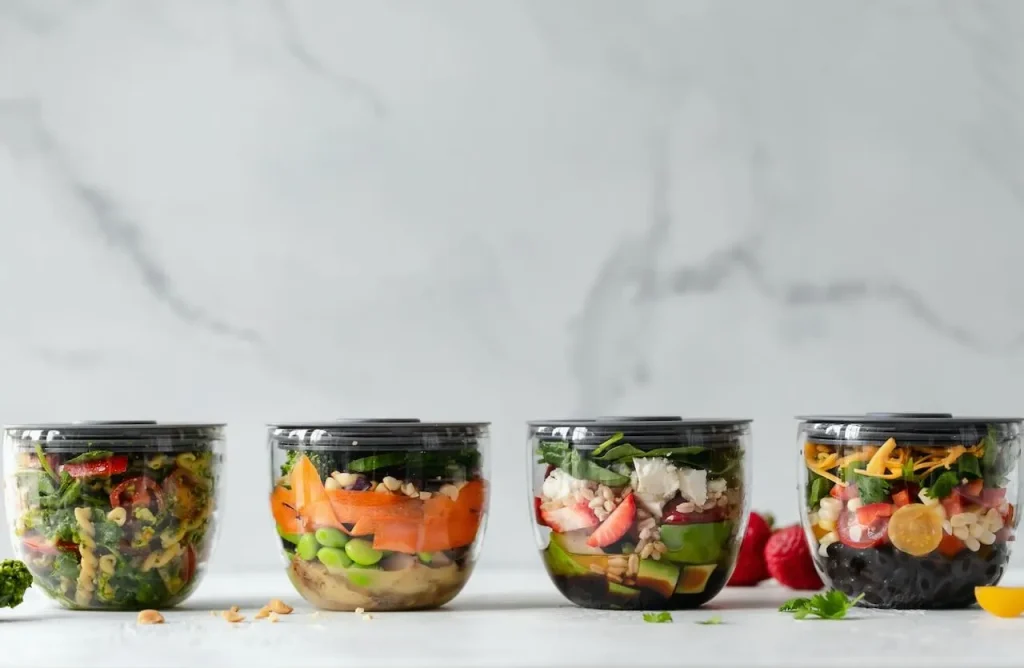

Hydrate
Staying hydrated plays a vital role in maintaining essential bodily functions. Aim to drink plenty of water throughout the day. Herbal teas can also be a good source of hydration and are packed with antioxidants.
Read Labels
Avoid foods with additives, preservatives, and sugars. The best way to do this is by reading and understanding food labels before purchasing.
Mindful Eating
Pay attention to your food while eating. Eat slowly, savor each bite, and listen to your body’s hunger and fullness signals. It helps to maintain healthy portions and enjoy the food.
Exercise
Regular exercise stabilizes inflammatory chemicals in your body. Intricate it into your routine in a way that is fun and sustainable.


Stress Management
Chronic stress aggravates inflammation. Techniques to manage stress—such as yoga, meditation, mindfulness, deep breathing, tai chi, or simply spending time in nature—can counteract this effect. Even a few minutes per day spent on relaxation can make a big difference.
Adequate Sleep
Prioritizing good-quality sleep helps the body to rest and repair. Sleep disturbances can trigger inflammation, so aim for 7–9 hours of sleep per night.
Quit Smoking
If you’re smoking, work on quitting. Smoking triggers an inflammatory response and predisposes you to numerous health risks.
Healthy Fats are Good
Not all fats are bad. Foods like avocados, nuts, seeds, and fish like salmon and mackerel are rich in inflammation-fighting Omega-3 fatty acids.
Eat the Rainbow
Aim to fill your plate with colorful fruits and vegetables. Each color offers unique nutrients and antioxidants.
Patience is a Virtue
Remember that it’s not about a quick fix, but sustaining a healthy lifestyle. Be patient with yourself; it’s okay if you do not see instantaneous results.
Seek Professional Advice
If you have any dietary restrictions, allergies, or chronic conditions, seek guidance from a healthcare professional or a dietitian before starting any new diet plan.
Remember, the goal here is to make long-lasting changes to your lifestyle that will help control inflammation and boost overall health and well-being.
General FAQ
Can I Follow the Anti-Inflammatory Diet if I Have Food Allergies or Dietary Restrictions?
Absolutely. The anti-inflammatory diet is highly flexible and can be adjusted to suit any dietary needs or restrictions. Just be sure to consult with a healthcare provider or dietitian before making any substantial changes to your diet.


How Will I Feel While on the Anti-Inflammatory Diet?
Expect your body to take some time to adjust to the new eating habits. You might feel hungry initially if you’re eating smaller and healthier portions. Eventually, you’ll notice increased energy levels, better digestion, improved skin health, and enhanced mood.
Is Exercise a Must on this 21-Day Plan?
Exercise isn’t a “must,” but it’s highly recommended as it helps manage inflammation. Any form of moderate-speed activity, for at least 30 minutes a day or most days of the week, can boost your results.
Can I Drink Alcohol on the Anti-Inflammatory Diet?
Moderate alcohol consumption, especially red wine, can potentially offer anti-inflammatory benefits. However, excessive alcohol consumption can increase inflammation. Try to limit yourself to one drink a day for women and up to two drinks a day for men.
What if I Feel Hungry Between Meals?
Detoxifying your body from sugar and processed foods can result in hunger pangs early in the diet. Feel free to add healthy, anti-inflammatory snacks to your diet plan, such as a handful of nuts, a piece of fresh fruit, or a serving of Greek yogurt with berries.
Is it Necessary to Count Calories While on this Diet?
The primary goal is to focus on food quality rather than calorie content. That said, portion control is still essential. It’s about getting a variety of nutrients from wholesome foods while keeping a check on portions to avoid overeating.
Conclusion
We’re thrilled to have walked alongside you in charting out this path to better health and less inflammation.
Remember, the essence of this diet plan doesn’t revolve around strict limitations or daunting food elimination. Instead, it’s centered on enjoying a variety of wholesome, inflammation-busting foods and nurturing lifestyle practices that boost your wellness game. The beauty of the plan is rooted in its flexibility and adaptability. This isn’t about perfection; it’s about progress and making better choices each day.
In these 21 days, and beyond, we hope you taste the flavors of good health, experience the vibrancy of balanced wellbeing, and cultivate the insights and habits that help you on your journey to reducing inflammation.
We wish you an inspiring journey toward less inflammation, better health, and enriched living. Here’s to celebrating the deliciousness of good health, one anti-inflammatory dish at a time! Enjoy it, and may your wellness journey be filled with joy and ample nourishment.
FAQ Regarding Anti-Inflammatory Drugs
Important reminder! Before using medications for pain relief, it’s best to consult with a healthcare professional.
Is Tylenol an Anti-Inflammatory?
Tylenol is not considered an anti-inflammatory medication. While it helps manage pain, it does not specifically target inflammation.
Tylenol works by blocking certain chemical signals in the brain that cause pain and fever. Unlike nonsteroidal anti-inflammatory drugs (NSAIDs), such as ibuprofen or naproxen, Tylenol doesn’t directly reduce inflammation. This makes it a good option for pain relief when inflammation is not the underlying issue, but less effective when swelling or inflammation is present.
Common side effects of Tylenol are usually mild but can include nausea or headaches. One of the biggest concerns is that high doses or prolonged use can cause liver damage. Since Tylenol does not reduce inflammation, it might not address the root cause of pain if it’s related to inflammatory conditions, potentially leading to overuse.
Is Tylenol an Anti-Inflammatory?
Tylenol is not considered an anti-inflammatory medication. While it helps manage pain, it does not specifically target inflammation.
Tylenol works by blocking certain chemical signals in the brain that cause pain and fever. Unlike nonsteroidal anti-inflammatory drugs (NSAIDs), such as ibuprofen or naproxen, Tylenol doesn’t directly reduce inflammation. This makes it a good option for pain relief when inflammation is not the underlying issue, but less effective when swelling or inflammation is present.
Common side effects of Tylenol are usually mild but can include nausea or headaches. One of the biggest concerns is that high doses or prolonged use can cause liver damage. Since Tylenol does not reduce inflammation, it might not address the root cause of pain if it’s related to inflammatory conditions, potentially leading to overuse.
Is Aleve an anti-inflammatory?
Aleve is an anti-inflammatory medication, meaning it not only relieves pain and reduces fever but also helps reduce inflammation in the body. Known generically as naproxen, is a commonly used over-the-counter medication that belongs to the class of drugs called nonsteroidal anti-inflammatory drugs (NSAIDs).
Aleve works by blocking the production of certain chemical signals called prostaglandins, which play a role in inflammation, pain, and fever. By reducing these chemicals, Aleve helps decrease swelling, redness, and discomfort caused by inflammation, making it particularly effective for conditions like arthritis, muscle strains, or other inflammatory conditions.
While Aleve is effective at reducing inflammation, it comes with potential side effects, especially with long-term use. Common side effects include stomach irritation, nausea, heartburn, and increased risk of ulcers or gastrointestinal bleeding. Aleve can also raise blood pressure and, in rare cases, affect kidney function. It’s important to follow dosing guidelines to minimize these risks.
Is Ibuprofen an Anti-Inflammatory?
Ibuprofen is an anti-inflammatory medication, effective in reducing pain, fever, and inflammation.
Ibuprofen works by inhibiting the enzyme cyclooxygenase (COX), which helps produce prostaglandins. Prostaglandins are chemicals responsible for promoting inflammation, pain, and fever in the body. By blocking their production, ibuprofen reduces inflammation and provides relief from swelling and discomfort caused by conditions such as arthritis, muscle pain, or injury.
Though ibuprofen is effective in reducing inflammation, it can cause side effects, particularly with prolonged use or high doses. Common side effects include stomach irritation, nausea, heartburn, and an increased risk of gastrointestinal bleeding or ulcers. Other potential risks include elevated blood pressure, kidney issues, and increased risk of heart problems. It’s important to follow recommended doses and avoid long-term use without medical supervision.
Is Tramadol an Anti-Inflammatory?
Tramadol is not an anti-inflammatory. Tramadol is a prescription pain medication that belongs to the class of opioid analgesics. It is effective at managing moderate to severe pain.
Tramadol works by binding to opioid receptors in the brain, which helps change how your body feels and responds to pain. It also influences the levels of certain neurotransmitters, such as serotonin and norepinephrine, which can contribute to pain relief. However, since tramadol doesn’t affect inflammation, it’s not useful in conditions where reducing swelling or inflammation is needed.
Tramadol can have significant side effects, especially since it is an opioid. Common side effects include dizziness, drowsiness, nausea, constipation, and headaches. More serious side effects can include addiction, respiratory depression, and withdrawal symptoms if used long-term or at high doses. Since it doesn’t address inflammation, tramadol may not be ideal for inflammatory conditions, and its side effects should be carefully considered.
Is Motrin an Anti-Inflammatory?
Motrin is an anti-inflammatory, commonly used to reduce pain, fever, and inflammation. It is widely available over-the-counter and prescribed for various conditions related to inflammation.
Motrin works by inhibiting the enzyme cyclooxygenase (COX), which is responsible for producing prostaglandins, chemicals that trigger inflammation, pain, and fever. By reducing prostaglandin production, Motrin effectively decreases inflammation and provides relief from conditions like arthritis, muscle injuries, and other inflammatory ailments.
Like other NSAIDs, Motrin can cause side effects, particularly with long-term or high-dose use. Common side effects include stomach pain, heartburn, nausea, and the risk of gastrointestinal bleeding or ulcers. Long-term use may also increase the risk of kidney damage and cardiovascular issues. It’s essential to follow recommended dosages and avoid prolonged use without medical advice.
Is Acetaminophen an Anti-Inflammatory?
Acetaminophen is not an anti-inflammatory. It alleviates pain but does not reduce inflammation or swelling, making it different from nonsteroidal anti-inflammatory drugs (NSAIDs) like ibuprofen.
Acetaminophen works by inhibiting the production of chemical messengers in the brain that signal pain and regulate body temperature. However, it does not have the same effect on inflammation as NSAIDs because it doesn’t inhibit the production of prostaglandins in peripheral tissues, which are involved in inflammation.
Acetaminophen is generally well-tolerated, but excessive use can lead to serious side effects, particularly liver damage. Unlike NSAIDs, acetaminophen doesn’t cause gastrointestinal issues like ulcers or stomach bleeding. However, it’s essential to stick to recommended dosages, as liver toxicity can occur with high doses or long-term use.
Is Marijuana an Anti-Inflammatory?
Research suggests that marijuana does have anti-inflammatory properties, particularly through the action of cannabidiol (CBD), a non-psychoactive component of the plant. However, its use as an anti-inflammatory agent is still being studied, and effects can vary based on the type of marijuana, dosage, and form of consumption.
Cannabinoids in marijuana interact with the body’s endocannabinoid system, which helps regulate various processes, including inflammation. CBD is thought to suppress inflammatory responses by modulating immune cell activity and reducing the release of inflammatory chemicals like cytokines. THC, the psychoactive compound, also has some anti-inflammatory effects, though its impact on inflammation is not as well-studied as CBD’s.
Marijuana use can lead to several side effects, especially when consumed in higher doses or over long periods. Common side effects include dizziness, dry mouth, altered mental state (due to THC), and impaired coordination. For some users, long-term or heavy use can lead to dependency, mental health issues, or cognitive impairment. Inhaling marijuana (smoking) can also irritate the lungs, which may be counterproductive for those dealing with inflammation-related conditions.
Is Advil an Anti-Inflammatory?
Advil is an anti-inflammatory medication that helps relieve pain, reduce fever, and decrease inflammation, making it effective for a range of conditions such as headaches, muscle aches, and arthritis.
Advil works by inhibiting the cyclooxygenase (COX) enzymes, which are involved in the production of prostaglandins, chemicals that promote inflammation, pain, and fever. By blocking these enzymes, Advil reduces swelling, pain, and discomfort in the body, making it an effective option for managing inflammatory conditions.
While Advil is effective at reducing inflammation, it can cause side effects, especially with long-term or excessive use. Common side effects include stomach irritation, nausea, heartburn, and the risk of ulcers or gastrointestinal bleeding. Long-term use may also increase the risk of kidney damage, high blood pressure, and cardiovascular issues. It’s essential to follow dosing instructions to minimize these risks.
Is Naproxen an Anti-Inflammatory?
Naproxen is an anti-inflammatory medication that helps reduce pain, inflammation, and fever. It’s commonly used for conditions like arthritis, muscle pain, and headaches.
Naproxen works by inhibiting the cyclooxygenase (COX) enzymes, which are responsible for the production of prostaglandins, chemicals that cause inflammation, pain, and fever. By blocking these enzymes, naproxen reduces inflammation and alleviates symptoms such as swelling and discomfort, making it effective for treating various inflammatory conditions.
Naproxen, like other NSAIDs, can cause side effects, especially with long-term or high-dose use. Common side effects include stomach pain, heartburn, nausea, and an increased risk of gastrointestinal bleeding or ulcers. Long-term use may also elevate the risk of heart problems, high blood pressure, and kidney damage. Always adhere to recommended dosages to avoid these risks.
Is Kratom an Anti-Inflammatory?
Kratom is not officially classified as an anti-inflammatory. Some users and limited studies suggest that it may have anti-inflammatory properties due to its active compounds, particularly mitragynine and 7-hydroxymitragynine.
Kratom works mainly by interacting with the brain’s opioid receptors, providing pain relief and sedative effects similar to those of opioids. Although there’s anecdotal evidence and emerging research pointing to kratom’s potential anti-inflammatory effects, its primary mechanism is pain relief rather than direct reduction of inflammation. Its impact on inflammation is still being studied, and results are not conclusive.
Kratom can cause a variety of side effects, particularly with frequent or high-dose use. These include nausea, constipation, dizziness, and in some cases, dependency or withdrawal symptoms. There are also concerns about liver toxicity with long-term use. Since kratom is not well-regulated, its use for inflammatory conditions should be approached cautiously, especially without medical supervision.
